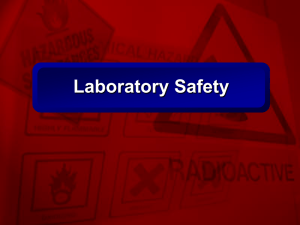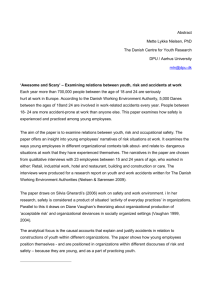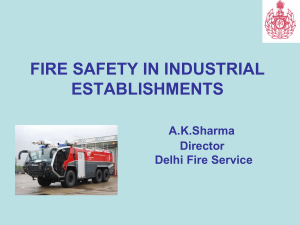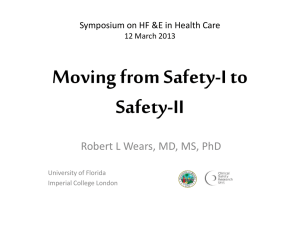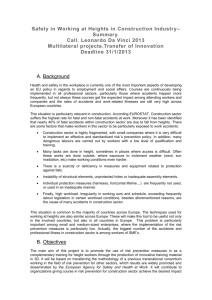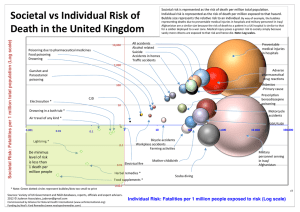Wg Cdr MU Khan
advertisement
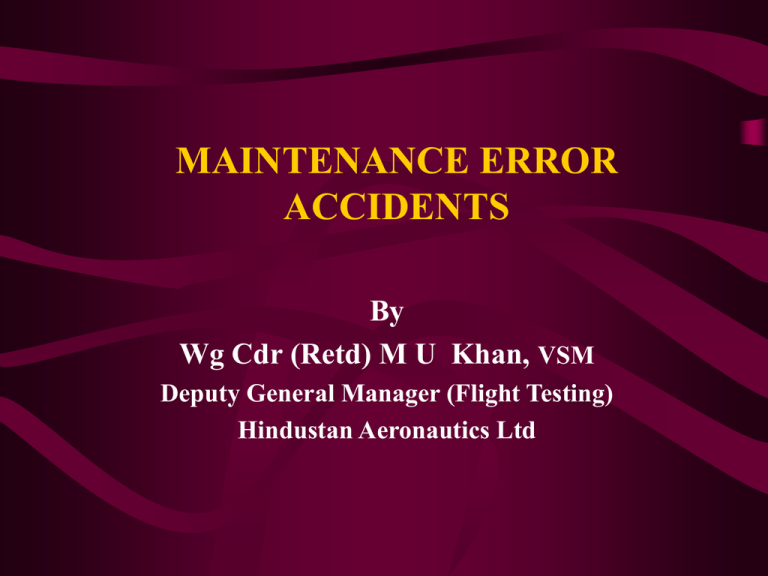
MAINTENANCE ERROR ACCIDENTS By Wg Cdr (Retd) M U Khan, VSM Deputy General Manager (Flight Testing) Hindustan Aeronautics Ltd Maintenance Error Accidents Maintenance is : – Essential & Integral part of aviation industry. Thus – Maintenance errors are likely to occur just like the flight crew related errors. Aim is to: – Minimise the risk of maintenance related accidents / incidents Content • Statistics of Indian Civil Helicopter Accidents due to Maintenance reasons • Contributory factors towards maintenance errors – Man – Machine – Environment • New Safety Requirements • Preventive and Predictive Maintenance • Future Trends Year Wise Statistics of Accidents (19902005) 8 7 No of Accidents 6 5 4 3 2 1 0 1990 1991 1992 1993 1994 1995 1996 1997 1998 1999 2000 2001 2002 2003 2004 2005 Year Total Maintenance Statistics of Accidents (1990-2005) GROUND ACCIDENT 10% MAINTENANCE 28% OTHERS 5% PILOT ERROR 57% Breakdown of Maintenance Related Accidents (1990-2005) Technical Defects 60% Improper Maintenance 40% Fatal : 2 Substantial Damage : 8 Injury : 1 Total Loss :3 Maintenance Issues IMPROPER MAINTENANCE • Incorrect Attachment • Incorrect Connection • Omission TECHNICAL DEFECTS • Fatigue Failure • Improper Manufacture • Incorrect Assembly • Wrong part • Internal Failures • Reversed Installation • Wrong Judgement • Faulty Design • Improper tool/equipment • Faulty Mfg Process Maintenance Errors - Factors MAN MACHINE ENVIRONMENT Maintenance Errors ERRORS • Oversight • Attention lapses VIOLATIONS • Non-compliance of laid down instructions or regulations - Someone in most maintenance departments make life or death decisions everyday. - They determine if an aircraft is safe for flight or not. - Most component technical issues in helicopters fall into shades of gray category thus • The maintenance personnel have a tough task to perform to keep the fleet airborne. • Their decision is easy if it’s a major safety of flight issue – ‘The aircraft is down’. • It is more difficult if it’s a minor discrepancy like metal chips in a transmission, a leaky actuator or minor cracks in secondary / tertiary structures. • All military & commercial aircraft fly with minor discrepancies. THE INDIVIDUAL WHO MAKES SAFETY OF FLIGHT DECISION CAN’T MAKE MISTAKES However, – Not all errors lead to incidents / accidents. – Individuals usually realise their mistakes and rectify them. – Research has shown that people involved in critical professions routinely make small mistakes, which they detect and correct themselves. Other Human Factors • • • • • • • • • • Lack of Communication Complacency Distraction Lack of Knowledge Lack of Teamwork Fatigue Lack of Assertiveness Stress Lack of Resources Pressure Environmental Aspects • Mostly all maintenance activities take place by night in artificial lighting conditions. • Hangars & Tarmac may not be always available at all times for maintenance operations. • Heat, Dust, Rain etc can be source of initiation of maintenance related incidents / accidents. Errors due to the Machine • The helicopter is a very complex machine as compared to its fixed wing counterpart. • It operates in adverse environment such as dusty and salt laden atmosphere as well as close to ground. Thus making it maintenance intensive. • Present concept is to make the design for near Zero routine maintenance for short terms and ‘inspect & replace’ for the longer term maintenance cycles. Avoid Maintenance Errors thru Design • Design features known to be a source of human errors are eliminated • Software logic to prevent errors • HUMS (Health & Usage Monitoring system) • IETMS (Interactive Electronic Technical Manuals) • Onboard Diagnostics MODERN HELICOPTER ON-BOARD DIAGNOSTICS Preventive Vs Predictive Maintenance • Maintenance professionals emphasize prevention as an inexpensive method of controlling maintenance costs and ensuring safety. • Technology has now advanced to such a point that a new trend has emerged – Predictive Maintenance. • But the two are not mutually exclusive. • An operator who has adopted both approaches is unlikely to get an unwelcome surprise from maintenance problems. • However the future is towards predictive maintenance. Future Trends in Maintenance • Onboard diagnostic systems to not only record but also to analyse the data during the flight. • Possibly relay the same to the maintenance agency to ensure ‘just in time’ deliveries of replacement parts rather than stockpiling them. • Nanotechnology. • Smart materials. • Virtual Retinal Display. Conclusion • The human aspect of the maintenance personnel is the most important area and needs careful attention by both – the operator and the regulator. • The environment plays a major role in ensuring proper maintenance of our helicopters and thus requires careful attention. • Modern technologies can aid reduction in maintenance error accidents.

